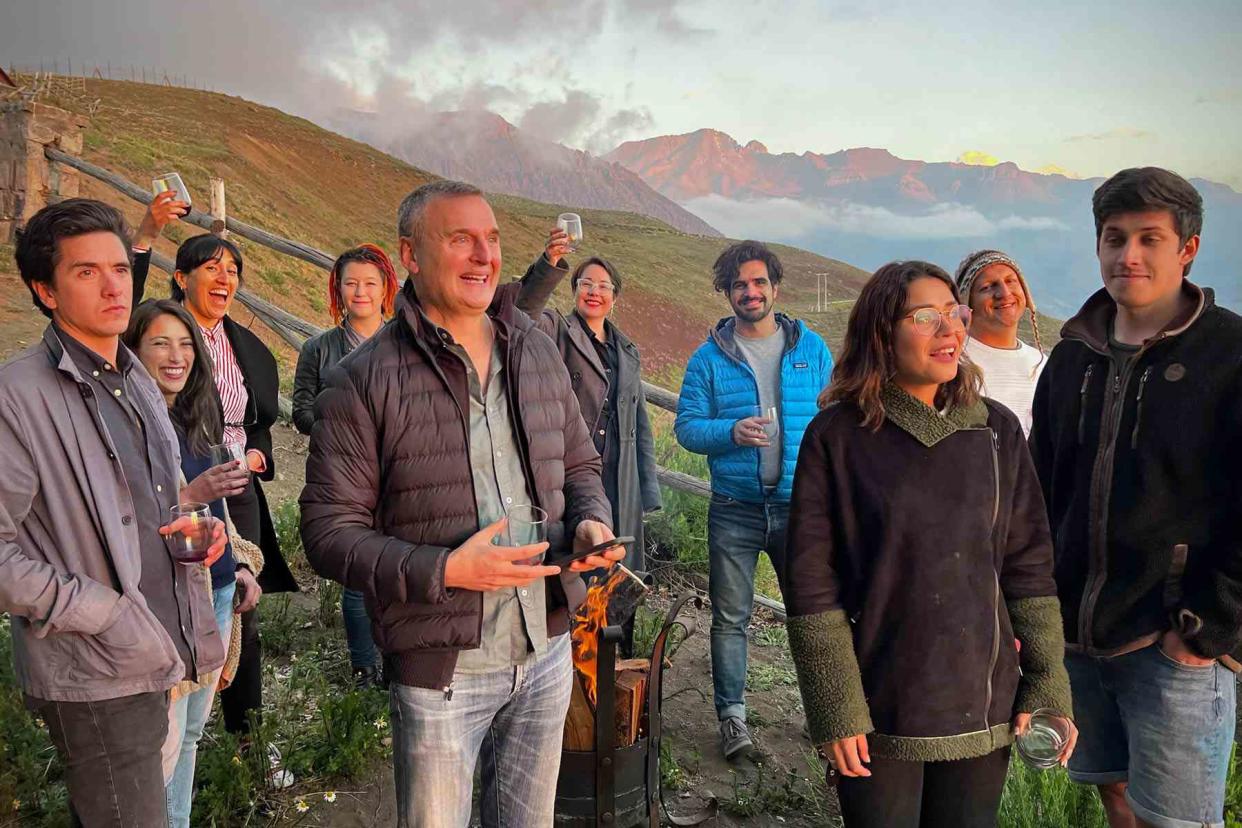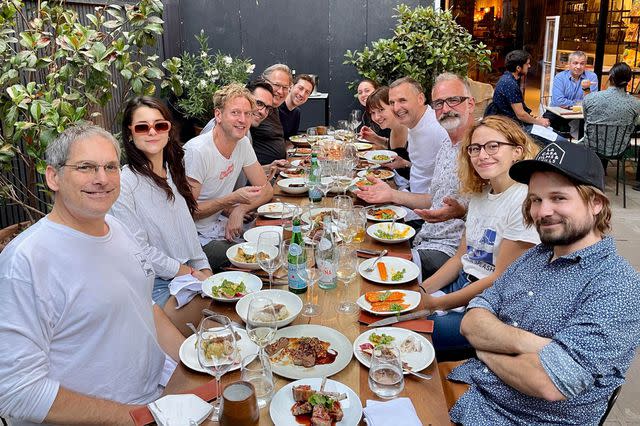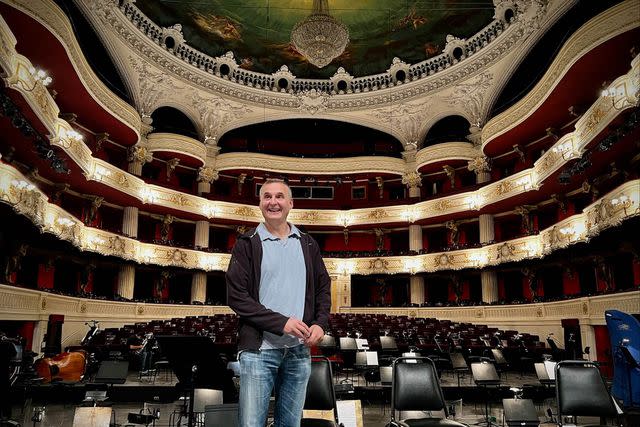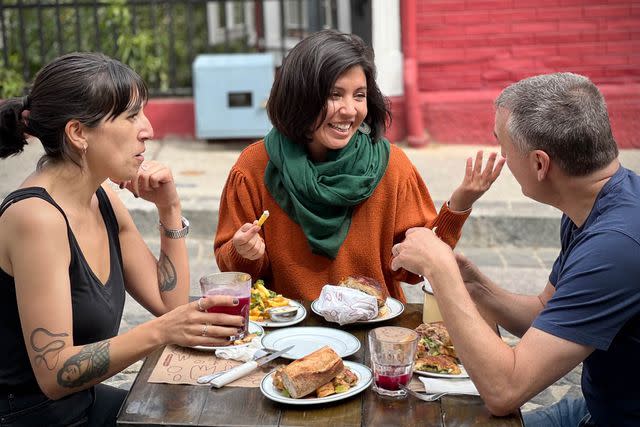I Went to Chile With Phil Rosenthal of 'Somebody Feed Phil' — and Learned His Greatest Travel Secret

Richard Rosenthal
- Oops!Something went wrong.Please try again later.
Phil Rosenthal never has a bad day. I know this because I traveled with Phil for a week while he and his team shot an episode in Santiago, Chile, for the newest season of his eponymous show, Somebody Feed Phil.
I know he doesn’t have a bad day because I watched Phil enjoy going to the airport in Los Angeles (an admittedly miserable experience). I know this because he didn’t complain when we had to wait in long lines to get COVID tests in the Santiago airport and quarantine ourselves in the hotel until our results arrived. I know this because each day of the week was filled with endless amounts of optimism, jokes, and boyhood wonder that a kid from Queens gets to do this job for a living.
Phil is a different kind of celebrity. He’s equal parts anonymous and famous. He can walk through an entire city without a hassle but every day he gets stopped at least once and takes a photo with a fan without fail. He’s a 62-year-old white male who somehow appeals to demographics of every race, religion, creed, and gender. He offends no one.
And if you ask him about this fascinating little world he’s carved out for himself, he’ll just say he’s lucky to be here. But Phil knows the secret to this world, and the secret is what’s behind the magic of the show.
This is a week behind the scenes with Phil and his crew in Santiago. The food he ate. The places he went. The happy accidents along the way. And the secret that is right in front of us, every single day.
Day 1

Richard Rosenthal
The first thing to know about Phil is that he is a walker. One mile, three miles, it doesn’t seem to matter. Phil wants to walk, see the city, meet some people, and immerse himself in a place.
“The best way to see a city is to walk around. It’s good exercise, number one. This is the way I usually am when I’m a tourist — I walk and walk and walk and walk until I find a place that’s good for lunch. And then I walk and walk and walk and walk until dinner,” Phil jokingly explains.
Post-quarantine, we got our first walk, a 1.5-mile jaunt to La Mesa restaurant with Phil and his brother Richard, who produces the show. The brothers have a shared language, having traveled the world together. The conversations ultimately come down to food, food portions, and food jokes.
There’s a buzz in Santiago. Graffiti litters nearly every wall, echoing a revolution that was stalled by COVID in early 2020. But a referendum on gay marriage is only days away and a massively consequential presidential election is next week. The city has changing energy and you feel it everywhere.
Walking to La Mesa, we’re stopped on the street by two Jewish, Venezuelan tourists who love Phil because he also happens to be Jewish, and because Netflix’s global appeal has no bounds. Phil stops for a photo. He always stops.
“There’s no bigger thrill in the world than for that to happen. And it’s because of Netflix. Netflix has endless reach,” Phil says with his perma-smile.
Five minutes later, a man stops his car in the middle of traffic and yells out Phil’s name. He jumps out of his car and hastily runs over to grab a pic with Phil, who is more than happy to oblige. The sounds of horns mean nothing.
We arrive at La Mesa, whose name means "the table" and echoes one of Phil’s mantras that all problems could be solved over a meal at a table. The restaurant patio is a greenery-filled garden with hanging lights and long wooden tables.
Phil’s crew waits for us as they down Pisco sours and Chilean beer while reminiscing about past episodes of the show in far off lands. They’re a band of brothers and sisters, a tight-knit crew who are lovers of food and travel.
Before the group begins production on an episode of the show, Phil gathers them all together for a family meal. It epitomizes the underlying magic of their show – it’s all about family.
“I would be nothing without this crew. They cover my buns, they buoy me, and they are fun. We laugh a lot. You know, any time you do a show, you become a family if you do it right. And now I have this really tight-knit family; the more we get to do the show, the closer we become. I know about their personal lives. I know what they like and what they don't like, and I love feeding them.”
More on the feeding them later.
Amidst a slew of inside jokes and more Pisco sours, La Mesa chef Álvaro Romero bludgeons us with the entire menu of Chilean seafood delights – oysters, ceviche, terrines, lobster, lamb chops (not seafood), and more. It’s good to be on this crew, and this is only night one.
Day 2

Richard Rosenthal
Most everything on the production in Chile is planned: where they shoot, how they shoot, when they eat, and who they meet. But the show’s lean and fungible crew make it easy to change things on the fly.
“I hate doing second takes on anything. It ruins the spontaneity. I’ll get notes from an executive who might hear the crew laugh and want to cut it, but we’re not hiding that we’re doing a TV show, so we leave it in.”
The first day of shooting finds Phil and team shooting B-roll throughout the city. Shots in front of government buildings, famous statues, and popular plazas that will infuse the show with Phil’s sense of awe while strolling through the streets.
We stop in Plaza de Armas, the main square in Santiago, surrounded by stately buildings, and lousy with palm trees, secret lovers, vagrants, and stray dogs. Phil incorporates everything into the shot, most especially the dog, who acts as our bodyguard when anyone else gets too close to the cameras.
One of the main obstacles the crew is encountering is finding shots without people’s masks on. The goal is to make the show aspirational and timeless, and masks make you think of the pandemic – not the desire to explore and discover.
Because of the impromptu nature of the show, the crew is always ready with releases for people to sign to ensure they can be shown on camera without any future lawsuits. Everyone signs the release.
“We were in Helsinki, and I had some pizza, and I was giving away pizza to the people and this one lady who I had a great conversation with wouldn’t sign the release. But most people like to be on TV,” Phil said.
From the plaza, we head to the Municipal Theatre of Santiago. The national theater, opened in 1857, is home to the country’s most indelible operas and stage performances. Here, Phil is in his element. He’s an artist’s artist who appreciates every aspect of the creative process. His love of being on stage, smelling the dusty curtains, and fawning over the stunning balcony seats is pure Phil. He says hi to everyone, takes photos with everyone. Theater people love him for a reason.
There’s nothing cool about Phil. He walks around the city in dad jeans and a tattered hoodie. He’s the antithesis of Anthony Bourdain, yet his relatability and authenticity are what draws a loyal following. In that way, he and Bourdain are more kindred spirits than one would think.
Between shots, Phil and I walk through random neighborhoods and alleyways admiring the ornate graffiti and stopping to say hi to strangers on the street. Phil loves to walk, and when he sees something he likes, he calls the crew and gets more B-roll for the show. It's unplanned, but instinctively spot on.
When shooting a show like this – tight, lean, and fast – the crew packs a lot into a day. After B-roll in the morning though, Phil begins to eat.
Santiago is known for an array of sandwiches, like the Churrasco, which is a thinly sliced steak sandwich with heaps of mayo, avocado, and tomato. There’s the El Lomito, a pork loin sandy with more mayo. And the El Completo, a hot dog with sauerkraut, onions, tomatoes, and more mayo (sensing a theme).
One of the stops was at Antigua Fuente, a shop serving Completos since 1968. Located a block from Plaza Baquedano, it’s one of the few stores that wasn’t destroyed during mass protests before the pandemic. The central meeting place saw hundreds of thousands of protestors who took care to spare a beloved sandwich shop while shouting for political change.
It’s not lost on the crew that they’re standing in a hotbed of political upheaval on the day same-sex marriage was legalized. It’s a groundbreaking moment for Chile and all of South America.
The next stop was in Santiago’s Meat Packing District at an outdoor sandwich shop named Pica de Jaime. The streets are jam-packed with shoulder-to-shoulder eaters looking for meat sandwiches. Heat pours off the open grills against the steaming concrete from the berating sun. Here, the pork sandwiches are as big as your head and Phil graciously shares every bite with his crew who pass each sandwich to one another, mid-shot, to devour the tidings by hand. Like I said, they’re a family, and this is how a family shares its food.
The final stop is at Liguria, a famous restaurant and bar that’s been slinging fried fish sandwiches for more than 120 years. Here, hipster bartenders pour Pisco sours and clever craft cocktails while a blind piano player serenades the proceedings. Phil’s eyes light up with every bite.
Phil doesn’t eat alone; gregariousness is his form of godliness. There are no empty stomachs on his crew and it’s part of the reason this group keeps coming back episode after episode. Who wouldn’t want to film all over the world, eat the best food (even if it’s second hand) and bask in a new culture of incredible treats? He orders extra sandwiches for everyone because these were the best, and you can’t leave without eating the best.
The bartenders offer a toast, explaining that what happens at Liguria stays at Liguria and that if you break eye contact while you toast, you’ll have seven years of bad sex. Without missing a beat, Phil exclaims, “That’s what I have already!” and downs his drink with aplomb.
Day 3

Richard Rosenthal
Phil and the crew are extra plucky this morning because they know they’re heading to Boragó, the world’s 38th best ranked restaurant helmed by molecular gastronomy specialist Rodolfo Guzmán.
We join the master chef in his laboratory, a spotlessly cleaned kitchen/apothecary with unnamed jars filled with fermenting concoctions that will shock and awe guests in three-to-five years from now. A chalkboard is littered with ingredients reminiscent of "A Beautiful Mind," where insanity meets genius. Guzmán is not screwing around.
Phil is hand-fed freshly cut lamb ribs that have been roasting over an open fire pit. Regardless of the prestige, Phil still feeds his crew slices by hand. The lab is a foodie’s dreamscape where Guzmán wows with local specialties like sea strawberries, succulents that surprise with a strawberry flavor and odor mixed with a briny aftertaste. And then there’s piure, an uni-like tunicate that grows on coral, is nature’s greatest hangover cure, and is said to mimic the effects of Viagra. Phil’s expression was somewhere between nausea and confusion.
From Boragó, the crew packs up and we all head out on the two-hour drive to Valparaiso, a coastal port city northwest of Santiago. The drive passes through vineyards, mountains, and desert and has hints of Northern California mixed with the east coast of Spain.
Valparaiso is known as Chile’s street art capital, and it’s easy to see why. Cobblestoned roads are buttressed by ornate murals covering every apartment and boutique shop. The hills of the city are a mix of old and new – dilapidated factories, chic restaurants, worn-out colonial houses, and trendy vintage stores.
Wandering the alleyways with Phil, we’re stopped, per usual, by a random fan. Only this fan tells Phil that he changed her life. The woman goes on to tell him how she and her boyfriend were moving to Lisbon because of watching his show. She’s overwhelmed that Phil is randomly in this small part of the world, as she calls her jealous boyfriend to regale him with the encounter.
But this was more than a brief encounter. So moved by the woman’s story, Phil ends up bringing her to the restaurant where he’s about to shoot another scene. He invites her to eat with him, now a part of the show itself. The restaurant, María maría, is an adorable hillside café with coffee, pastries, and remarkable sandwiches on homemade sourdough.

Richard Rosenthal
But the highlight for Phil wasn’t the food, it was being able to give this random woman one of the greatest moments of her life. It’s small accidents like these that make this show special and different.
Valparaiso may be known for its art scene, but it’s also not the safest city in the world, especially in the area where they're shooting. A crew carrying thousands of dollars of camera equipment and ferrying around an international celebrity tends to attract attention.
Likely unbeknownst to Phil, the crew had to fight off a thief who tried to snag their drone. One of the crew members nearly broke his finger and lost a camera lens and an SD card. But this is the chaos of production, and it’s not the first time the crew has had run-ins around the globe.
<strong> </strong>Day 4
The crew has seen some things. There was the stolen phone in Vietnam. There was the car crash in Nashville. There was the canceled episode in Puglia when the show’s director got COVID and was stuck in Madrid. And there were the riots in Rio. The drone theft was simply par for the course and this crew was barely fazed as they moved into day four of production.
Every episode of Somebody Feed Phil has an element of community outreach. For Chile, it’s visiting an Olla Comune, a soup kitchen that popped up during the pandemic to help bring meals to suffering communities. Run by the Por Todas Foundation, the kitchens dole out freshly cooked food to hungry Chileans who bring their own Tupperware to be filled. Phil joins the line to help feed the hungry, and in typical Phil fashion, play with the kids.
Running a production during COVID comes with a number of quirks. There are two nurses on staff at all times handing out N95 masks and continuously dousing everyone’s open hands with sanitizer. Phil gets tested for COVID every few days, and anyone interacting with Phil without a mask gets tested before the team begins shooting.
It almost boggles the mind that Phil has never contracted COVID. Even with these precautions, he rarely wears a mask himself, regularly interacts with anyone and everyone who approaches him on the street, and has been traveling around the entire world on commercial flights for months. Maybe optimism is the true vaccine?
After the soup kitchen, the crew moves over to Demencia, a gastropub from renowned Chilean chef Benjamin Nast with a large outdoor terrace and unmistakable neon sign with the name of the place flashing the street. The creative cuisine here is Asian/Chilean fusion with treats like rice cake mac ‘n cheese, divine miso-infused butter, and raw seafood doused in lilac oil and avocado. Phil’s eyes go wide with each bite, especially when combining the miso butter with the unbelievable sourdough bread from local bakery Popular.
A fan of the show, the baker from Popular personally stopped by to kvetch with Phil. In the middle of their meal, the baker’s wife went into labor, and the man rushed off. He then FaceTimed Phil enroute to the hospital, not wanting to miss out on his opportunity to share more of the meal with one of his favorite TV idols. Don’t be surprised if that baby somehow makes it onto the show as well.
The day ends with a stroll through the chaotic city center. Phil takes photos with more fans as the crew avoids the police, who are incredibly strict on permitting. The city’s stark contrasts all come into view as a crowd mingles around a candidate running for public office and shouts over a megaphone. Rich and poor, modern and old, past and future, the crush of traffic and smog, and Phil, smiling through it all in a constant state of awe.
“I tell people, I have the perfect level of fame right now. I wish this for everyone," he says. "Once or twice a day someone comes up to you and says they like you or you do a good job. I don't have that in my house. So, I wish everybody could have that feeling. You know, it's not like I'm Justin Timberlake and can't go outside. I love when people come and say hello. I wouldn't be doing what I do if I didn't like people. And they're always at least to me – maybe because I'm old – respectful and nice and nobody grabs me. You know, it's rare that they interrupt me while I'm eating but even that I don't really mind.”
Day 5
One of the most stunning meals of the entire production was served up by the inimitable couple at Ambrosía Bistro. Helmed by Chef Carolina Bazán and her partner/sommelier Rosario Onetto, the small, countertop joint brings a fine dining level of cooking to a casual eatery. Here, Phil devours fresh local seafood in a mix of Chilean and French cooking styles. Pork bao buns contrast with lettuce-wrapped taquitos and beef cheeks atop pomegranate beans. Natural wines are poured liberally for Phil and the entire crew who simultaneously marvel at the spectacular meal before them.
This meal had extra meaning, as the couple epitomized the new Santiago. A Santiago where gay marriage is now possible. A Santiago on the verge of electing the youngest president in their history who leans heavily on socialist ideals to bring equality to the masses. We all felt it with every bite.
For a show that packs in an intense number of scenes, day five was lean. After lunch, the team shot more B-roll around the city and wound up visiting Gran Torre Santiago, which is the tallest building in South America, towering 300 meters over the city. The vistas are stunning as drone footage captures Phil’s authentic reactions to how sprawling Santiago truly is. The city sits in the Maipo Valley and is surrounded by the epic snow-capped Andes Mountains. From the top of Gran Torre, you feel the nearly 7 million people living here, working here, eating here. It’s a colossal place and has earned its reputation as an excellent food haven.
“I didn't know what to expect. I had never been here before," Phil said. "I was surprised at how beautiful a lot of the city was, even after their recent revolution. I was surprised at how liberal it was becoming, they passed gay marriage while we were there. And then the most beautiful parks and then 15 minutes outside of town, we're in the Andes Mountains. So that's incredible. It's a spectacular place. I wish it wasn't an 11-hour trip.”
Day 6
On the final day of production, the crew meets up at La Calma restaurant run by chef Gabriel Layera, who is known as a seafood aficionado who forages for fresh daily catches and is widely credited for providing some of the best restaurants in town with their fish. Phil is joined by chefs Álvaro Romero of La Mesa and Benjamin Nast of Demencia. This trio of chefs is defining the future of Chilean cuisine and has formed a brotherhood that is helping put the city and country on the global foodie map.
After a cavalcade of Chilean seafood specialties, the entire crew breaks for a final lunch at this majestic spot. This is Phil’s road family. Eating together at one of the best restaurants in the city, feeding one another by hand, reminiscing about the crazy, jam-packed week, and gearing up for the final shot of the show.
The crew breaks and heads into the Andes Mountains. If you’ve seen the show, you know Phil invites everyone he’s met in the city for one last meal. The final meal here takes place in the beauty of Chile’s mountains. There’s an open fire, there’s a potluck. These are the absolute best chefs in the country and they’re all coming together for a family meal with Phil.
This is what this show is about. Connecting with a place, a people, and a culture, over a meal. It’s taking the idea of extended family around the world. The reason Phil’s show can change a woman’s life, make someone stop their car in the middle of traffic, or get a FaceTime from the delivery room is because Phil understands the secret. The secret is family. The crew, his brother, the people he meets, he knows it’s relatable to all, but it’s never forced. It’s always authentically about family.
“I think the show is everything I’ve learned over the years about how to make a show, how to tell a story, and it’s in the service of everything else I love in life. Which includes making shows by the way, which I love doing," he says. "But everything else I love in life is family, friends, food, travel, and laughs. And so this is, for me, the vehicle for that."
For more Travel & Leisure news, make sure to sign up for our newsletter!
Read the original article on Travel & Leisure.

